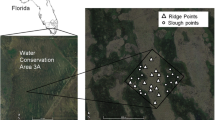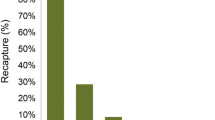Abstract
In recent decades, wetlands have been constructed or restored around the Baltic sea to counteract the eutrophication of its coastal waters. Some of these wetlands could also be suitable spawning and nursery areas for anadromous northern pike (Esox lucius L.). We studied juvenile pike production in three coastal wetlands along the south-eastern coast of Sweden that were restored in different ways. Where terrestrial vegetation was temporarily flooded, pike larval/juvenile emigration increased from a few thousand individuals before restoration to over a hundred thousand afterwards. We suggest that vegetation was the key to this successful reproduction, as wetlands where vegetation was removed or reduced saw no similar increase in pike production. Flooded vegetation in shallow waters offers optimal spawning conditions, increased food resources, and refuge from predation. The growth and emigration of larvae and juveniles were followed over time, revealing that 80–95% of individuals left the wetlands within 1 month (at a size <6 cm). This emigration probably represents an adaption to seasonally decreasing water levels but may also be a way to avoid cannibalism.





Similar content being viewed by others
References
Alström, T. & J. Krook, 2008. Att återskapa historiska våtmarker i Kävlingeåns avrinningsområde: möjligheter, hinder och praktiska erfarenheter. Ekologgruppen, Landskrona: 34 (in Swedish).
Billard, R., 1996. Reproduction of pike: gametogenesis, gamete biology and early development. In Craig, J. F. (ed.), Pike: biology and exploitation. Chapman & Hall, London: 13–43.
Bry, C., 1996. Role of vegetation in the life cycle of pike. In Craig, J. F. (ed.), Pike: biology and exploitation. Chapman & Hall, London: 45–67.
Casselman, J. M. & C. A. Lewis, 1996. Habitat requirements of northern pike (Esox lucius). Canadian Journal of Fisheries and Aquatic Sciences 53: 161–174.
Craig, J. F., 1996. Population dynamics, predation and role in the community. In Craig, J. F. (ed.), Pike: biology and exploitation. Chapman & Hall, London: 201–217.
Engstedt, O., 2011. Anadromous pike in the Baltic Sea. Doctoral thesis, Linnaeus University, Kalmar, 46 pp.
Engstedt, O., P. Stenroth, P. Larsson, L. Ljunggren & M. Elfman, 2010. Assessment of natal origin of pike (Esox lucius) in the Baltic Sea using Sr:Ca in otoliths. Environmental Biology of Fishes 89: 547–555.
Farrell, J. M., J. V. Mead & B. A. Murry, 2006. Protracted spawning of St Lawrence River northern pike (Esox lucius): simulated effects on survival, growth, and production. Ecology of Freshwater Fish 15: 169–179.
Forney, J. L., 1968. Production of young northern pike in a regulated marsh. New York Fish and Game Journal 15: 143–154.
Franklin, D. R. & L. L. Smith, 1963. Early life history of the northern pike (Esox lucius L.) with special reference to the factors influencing the numerical strength of year classes. Transactions of the American Fisheries Society 92: 91–110.
Grimm, M. P. & M. Klinge, 1996. Pike and some aspects of its dependence on vegetation. In Craig, J. F. (ed.), Pike: biology and exploitation. Chapman & Hall, London: 125–156.
Hagerberg, A., J. Krook & D. Reuterskiöld, 2004. Åmansboken: vård, skötsel och restaurering av åar i jordbruksbygd. Saxån–Braåns vattenvårdskomm, Landskrona (in Swedish).
Hansson, L.-A., C. Brönmark, P. A. Nilsson & K. Åbjörnsson, 2005. Conflicting demands on wetland ecosystem services: nutrient retention, biodiversity or both? Freshwater Biology 50: 705–714.
Hoffmann, M., H. Johnsson, A. Gustafson & A. Grimvall, 2000. Leaching of nitrogen in Swedish agriculture: a historical perspective. Agriculture, Ecosystems and Environment 80: 277–290.
Jeppesen, E., J. P. Jensen, M. Søndergaard, T. Lauridsen, L. J. Pedersen & L. Jensen, 1997. Top–down control in freshwater lakes: the role of nutrient state, submerged macrophytes and water depth. Hydrobiologia 342(343): 151–164.
Lappalainen, A., M. Härmä, S. Kuningas & L. Urho, 2008. Reproduction of pike (Esox lucius) in reed belt shores of the SW coast of Finland, Baltic Sea: a new survey approach. Boreal Environment Research 13: 370–380.
Larsson, U., R. Elmgren & F. Wulff, 1985. Eutrophication and the Baltic Sea: causes and consequences. Ambio 14: 9–14.
Lehtiniemi, M., T. Hakala, S. Saesmaa & M. Viitasalo, 2007. Prey selection by the larvae of three species of littoral fishes on natural zooplankton assemblages. Aquatic Ecology 41: 85–94.
Ljunggren, L., J. Olsson, J. Nilsson, P. Stenroth, P. Larsson, O. Engstedt, T. Borger & O. Sandström, 2011. Våtmarker som rekryteringsområden för gädda i Östersjön. Report, Finfo no. 1. Fiskeriverket, Kustlaboratoriet, Öregrund: 63 (in Swedish with English summary).
Montén, E., 1948. Research on the biology of northern pike larvae and some related problems. Skrifter utgivna av Södra Sveriges Fiskeriförening 1: 3–38 (in Swedish with English summary).
Müller, K., 1986. Seasonal anadromous migration of the pike (Esox lucius L.) in coastal areas of the northern Bothnian Sea. Archive für Hydrobiologie 107: 315–330.
Nilsson, J., 2006. Predation of northern pike (Esox lucius L.) eggs: a possible cause of regionally poor recruitment in the Baltic Sea. Hydrobiologia 553: 161–169.
Nilsson, J., J. Andersson, P. Karås & O. Sandström, 2004. Recruitment failure and decreasing catches of perch (Perca fluviatilis L.) and pike (Esox lucius L.) in the coastal waters of southeast Sweden. Boreal Environment Research 9: 295–306.
Paludan, C., F. E. Alexeyev, H. Drews, S. Fleischer, A. Fuglsang, T. Kindt, P. Kowalski, M. Moos, A. Radlowki, G. Stromfors, V. Westberg & K. Wolter, 2002. Wetland management to reduce Baltic Sea eutrophication. Water Science Technology 45: 87–94.
Raat, A. J. P., 1988. Synopsis of biological data on the northern pike, Esox lucius Linnaeus, 1758. FAO, Rome: 178.
Rozas, L. P. & W. E. Odum, 1988. Occupation of submerged aquatic vegetation by fishes: testing the roles of food and refuge. Oecologia 77: 101–106.
Skov, C., O. Lousdal, P. H. Johansen & S. Berg, 2003a. Piscivory of 0+ pike (Esox lucius L.) in a small eutrophic lake and its implication for biomanipulation. Hydrobiologia 506–509: 481–487.
Skov, C., L. Jacobsen & S. Berg, 2003b. Post-stocking survival of 0+ year pike in ponds as a function of water transparency, habitat complexity, prey availability and size heterogeneity. Journal of Fish Biology 62: 311–322.
Skov, C. & A. Koed, 2004. Habitat use of 0+ year pike in experimental ponds in relation to cannibalism, zooplankton, water transparency and habitat complexity. Journal of Fish Biology 64: 448–459.
Threinen, C. W., C. Wistrom, B. Apelgren & H. Snow, 1966. The northern pike, life history, ecology, and management. Wisconsin Conservation Department Publication No. 235, 16 pp.
Vahteri, P., A. Mokinen, S. Salovius & I. Vuorinen, 2000. Are drifting algal mats conquering the bottom of the Archipelago Sea, SW Finland? Ambio 29: 337–338.
Westin, L. & K. E. Limburg, 2002. Newly discovered reproductive isolation reveals sympatric populations of Esox lucius in the Baltic. Journal of Fish Biology 61: 1647–1652.
Wright, R. M. & N. Giles, 1987. The survival, growth and diet of pike fry, Esox lucius L., stocked at different densities in experimental ponds. Journal of Fish Biology 30: 617–629.
Acknowledgments
Financial support was provided by the Faculty of Natural Sciences, Engineering and Technology at Linnaeus University and the Swedish National Board of Fisheries. We also thank Christian Skov and two anonymous reviewers for constructive input regarding previous versions of this manuscript.
Author information
Authors and Affiliations
Corresponding author
Additional information
Handling editor: M. Power
Rights and permissions
About this article
Cite this article
Nilsson, J., Engstedt, O. & Larsson, P. Wetlands for northern pike (Esox lucius L.) recruitment in the Baltic Sea. Hydrobiologia 721, 145–154 (2014). https://doi.org/10.1007/s10750-013-1656-9
Received:
Revised:
Accepted:
Published:
Issue Date:
DOI: https://doi.org/10.1007/s10750-013-1656-9




